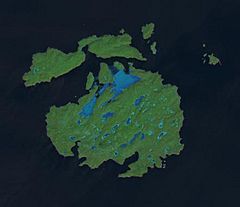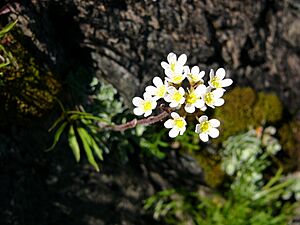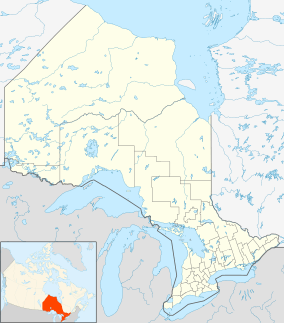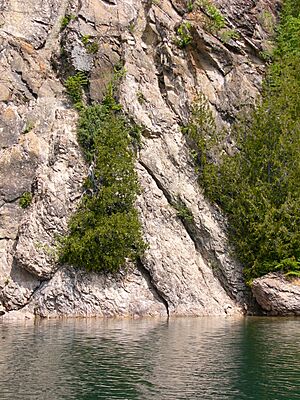Slate Islands (Ontario) facts for kids
Quick facts for kids Slate Islands Provincial Park |
|
|---|---|
|
IUCN Category II (National Park)
|
|

Landsat image (2019)
|
|
| Location | Ontario, Canada |
| Nearest city | Terrace Bay, Ontario |
| Area | 65.70 km2 (25.37 sq mi) |
| Established | 1985 |
| Governing body | Ontario Parks |
The Slate Islands are a group of islands in northern Lake Superior. They are about 10 kilometers (6 miles) south of Terrace Bay, Ontario. These islands were formed by a huge meteorite hitting the Earth. This impact created a crater about 32 kilometers (20 miles) wide.
In 1985, the Ontario government made the Slate Islands a special provincial park. This park helps protect the natural environment. The islands are famous for having the largest group of boreal woodland caribou in Ontario. The total land area of the islands is about 36 square kilometers (14 square miles).
Contents
Amazing Animals of the Slate Islands
The Slate Islands are home to many interesting animals. One of the most important animals here is the woodland caribou. Scientists have studied these caribou for many years, from 1974 to 2007.
The caribou on the islands are a great example of island biogeography. This is a science that looks at how animals live on islands. Some animals found on the mainland, like moose or squirrels, are not found on the Slate Islands. This is because islands can be hard for some species to reach.
Caribou only arrived on the islands in the early 1900s. There were no large plant-eating animals there before them. For a while, the Slate Islands had the most caribou per square mile in the world! Before the 1990s, there were about 650 caribou. But after a food shortage in 1990, their numbers dropped to about 100. By 2012, there were around 200 caribou.
Wolves came to the islands in the early 1990s and hunted the caribou. But then, for reasons scientists don't fully understand, the wolves disappeared. However, wolves have been seen on the islands again since 2015 or 2016.
Other animals living on the islands include beavers, muskrats, snowshoe hares, and red foxes.
The waters around the Slate Islands are also special. They are protected from commercial fishing. This helps keep one of the last natural groups of lake trout in Lake Superior safe. These lake trout are used to help bring back fish populations in other parts of Lake Superior.
Unique Plants of the Slate Islands

Lake Superior's cool temperatures make the Slate Islands a tough place for plants to grow. Because of this, you can find arctic and alpine plants here. These are plants that usually grow in very cold, northern areas or high mountains.
Some examples include alpine chickweed, which is found further south here than almost anywhere else. There's also Dryas drummondii, which isn't found again for another 1600 kilometers (1000 miles) north! You can also find alpine bistort, which is a plant eaten by the Inuit people with seal oil.
These arctic plants are like living reminders of the Ice Ages. Long ago, this area was covered in ice and had cold, treeless lands called tundra.
A Look at Human History
People have lived on the Slate Islands for a very long time. Scientists have found signs of human activity dating back to about 1000 CE.
In 1903, a lighthouse was built on Patterson Island. This is the largest island in the group. The lighthouse helped ships find their way to the nearby town of Jackfish, Ontario. Patterson Island is named after William Patterson, who was a leader in Saskatchewan. Later, a fishing station was built on McColl Island.
The forests on the islands have changed over time. People used to cut down trees (logging), and there were also forest fires. Until the 1940s, the islands were used to store logs that came from the mainland. These logs were then shipped on large boats called lake freighters to paper mills in the United States.
In 1985, the Slate Islands became an Ontario Natural Environment Provincial Park. There are no special buildings or places for visitors. You can only reach the islands by boat or airplane. The islands are far away from big towns, about 9 kilometers (5.6 miles) across open Lake Superior water. This makes them a quiet place. Many naturalists, people who love fishing, sailors, and sea kayakers visit the islands.
The Meteorite Impact Crater
The Slate Islands are at the very center of a huge meteorite impact crater. Scientists believe the original crater was about 32 kilometers (20 miles) wide. Over millions of years, most of the crater has worn away. What's left are the islands, which are thought to be the central part that pushed up after the impact.
Scientists estimate the impact happened about 450 million years ago. This was during a time called the Ordovician period. Some scientists think it might be one of several meteorites that fell around the same time, about 469 million years ago. This event is called the Ordovician meteor event. Other craters from this event include the Decorah crater in Iowa and the Ames crater in Oklahoma.
Island Geology: What the Islands are Made Of
Even though they are called the Slate Islands, they are not made of slate rock. The rocks here are mostly very old volcanic rocks, more than 2.7 billion years old! There are also sedimentary rocks from the Rove and Gunflint formations, which are about 1.85 to 2.10 billion years old.
About 1.1 billion years ago, there might have been a volcano on Patterson Island. But most of those volcanic rocks have worn away over time.
The youngest rocks are called diatremes. These are like pipes filled with broken rock, formed by gas explosions. They appear as thin rock layers called dikes or sills that cut through all the older rocks.
The islands also have amazing examples of shatter cones. These are rare rock shapes found in bedrock. They are formed by the powerful shock waves when a meteorite hits the Earth. Shatter cones have a cone shape with thin lines that spread out from the top. The Slate Islands are home to one of the largest shatter cones in the world, measuring about 9 meters (30 feet) tall!
See also
 In Spanish: Islas Slate (Ontario) para niños
In Spanish: Islas Slate (Ontario) para niños





